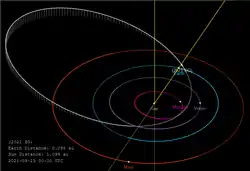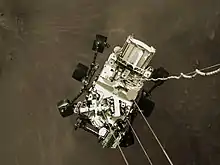 Orbit of 2021 SG | |
| Discovery [1][2] | |
|---|---|
| Discovered by | Zwicky Transient Facility |
| Discovery site | Palomar Obs. |
| Discovery date | 17 September 2020 |
| Designations | |
| 2021 SG | |
| ZTF0MtF [3] | |
| NEO · Apollo [4] | |
| Orbital characteristics [4] | |
| Epoch 21 January 2022 (JD 2459600.5) | |
| Uncertainty parameter 7 | |
| Observation arc | 7 days |
| Aphelion | 2.953 AU |
| Perihelion | 0.4730 AU |
| 1.713 AU | |
| Eccentricity | 0.7238 |
| 2.24 yr (818.77 days) | |
| 76.606° | |
| 0° 26m 22.869s / day | |
| Inclination | 3.176° |
| 352.203° | |
| 256.579° | |
| Earth MOID | 0.00157 AU (235,000 km) |
| Physical characteristics | |
Mean diameter | 42–94 m [5] |
| 13.4 (discovery) [2] | |
| 24.01±0.24 [4][1] | |
2021 SG is a near-Earth asteroid, with an estimated diameter of 42 to 94 meters, that passed about half a lunar distance from Earth on 16 September 2021. It approached from the direction of the Sun, so it was invisible until a day later.[6] It completes its highly eccentric orbit in 2.24 years. 2021 SG is an Apollo asteroid with a 1.71 AU semimajor axis, and a 0.473 AU perihelion (near Mercury at perihelion) out to a 2.95 AU aphelion (between Mars and Jupiter). With an absolute magnitude (H) of 24.0, it is possibly the largest asteroid to pass within 1 lunar distance of Earth during 2021.[2]
References
- 1 2 "2021 SG". Minor Planet Center. International Astronomical Union. Retrieved 11 December 2021.
- 1 2 3 "MPEC 2021-S24 : 2021 SG". Minor Planet Electronic Circular. Minor Planet Center. 17 September 2021. Retrieved 11 December 2021.
- ↑ "2021 SG". NEO Exchange. Las Cumbres Observatory. 17 September 2021. Retrieved 11 December 2021.
- 1 2 3 "JPL Small-Body Database Browser: (2021 SG)" (2021-09-24 last obs.). Jet Propulsion Laboratory. Retrieved 11 December 2021.
- ↑ "NEO Earth Close Approaches". Center for Near Earth Asteroid Studies. Jet Propulsion Laboratory. Retrieved 11 December 2021.
- ↑ "EarthSky | Asteroid 2021 SG came from the sun's direction". 20 September 2021.
External links
Wikimedia Commons has media related to 2021 SG.
- 2021 SG at the JPL Small-Body Database
This article is issued from Wikipedia. The text is licensed under Creative Commons - Attribution - Sharealike. Additional terms may apply for the media files.


